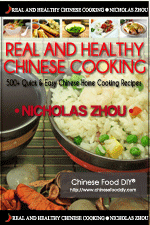|
"Governing a
great nation is much like cooking a small
fish."
(Lao Zi, Ancient Chinese Philosopher)
 Can you
imagine anything more cozy than gathering the family
around the kitchen table to feast on Chinese takeout
while enjoying a rousing game of Monopoly? Or more
romantic than lounging before a roaring fire,
splitting a couple of cartons of
ginger beef and
cashew chicken with your loved one? Can you
imagine anything more cozy than gathering the family
around the kitchen table to feast on Chinese takeout
while enjoying a rousing game of Monopoly? Or more
romantic than lounging before a roaring fire,
splitting a couple of cartons of
ginger beef and
cashew chicken with your loved one?
Perhaps
more than any other,
Chinese cuisine symbolizes
comfort and tradition. There are few people who
haven't celebrated at least one special occasion
with Asian cooking. And why not? As K.C. Chang
writes in
Food in Chinese Culture, "few other cultures are
as food-oriented as the Chinese." More than other
exotic cuisines, Chinese food seems made for ritual.
It's no accident that in the film A Christmas
Story, when the family's turkey dinner is
carried off by a pack of dogs, they salvage the day
by dining out at a Chinese restaurant. Ever
respectful of tradition, the restaurant's owner does
his best to invoke the Yuletide spirit, having his
waiters sing Christmas carols as the family dines on
duck - the only fowl available.
Of course,
our tastes have become much more sophisticated than
those simpler times. Instead of the ubiquitous
chop suey and
egg rolls, we now enjoy mouthwatering delicacies
that reflect regional variations in preparation and
cooking methods. Whether your taste runs to the
heavily spiced, meat and fish-based cuisine of the
northern regions, or to the more delicately seasoned
Cantonese cuisine found in the
Guangdong province, restaurants, books, and
cooking shows abound to aid you in your exploration
of Asian cuisine.
The
diversity in regional styles brings to light an
interesting fact: it is not the specific ingredients
that give Chinese cuisine its distinct character. No
doubt factors such as scarcity of arable land have
influenced the Chinese diet. But throughout the
centuries the Chinese have also shown a willingness
to adopt foreign foods (the peanut, for example).
And Chang writes that a truly skilled gourmand can
produce a Chinese meal using only native American
ingredients.
What makes
Chinese cuisine truly unique is the balancing of
ingredients. A proper Chinese meal always contains
an equal division of fan, grains and starches, and
t'sai, meat and vegetables. The two are never mixed
together, allowing each to retain its own unique
characteristics. The balance between fan and t'sai
fits in with the Chinese belief in the importance of
balance and harmony in every aspect of life. Perhaps
this is the reason we find Chinese cuisine so
comforting.
Click
here
to
know
more about Chinese Cuisine and get your FREE Healthy
Chinese recipes in your email.
[Back
to Chinese Cuisine Index]
Get ready to
cook Chinese food?
Click here to see
500+ Real and Healthy Chinese Food Recipes
in 5 minutes! Plus 200+ cooking
tips and 170+ colorful pictures.
|
"500+ Healthy Chinese Recipes in 5 minutes"
|

|
ChineseFoodDIY's
cookbook "Real & Healthy Chinese Cooking" -
500+ low carb and low fat recipes with 170+ colorful pictures.
Based on a master chef's 40 years of cooking practice and 4 years of writing
and research, it has helped over 12,800 people worldwide improve
their health. All the secret copy cat recipes in ONE cookbook.
Click here to read the whole story that reveals how
ANYONE can cook delicious Chinese food and improve their health... in less than 20
minutes. | |

|
